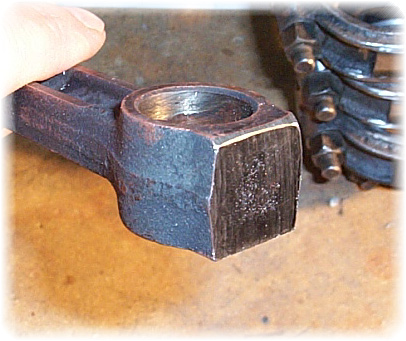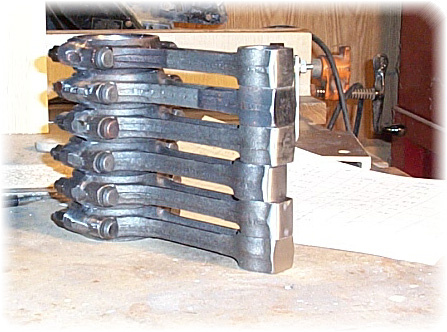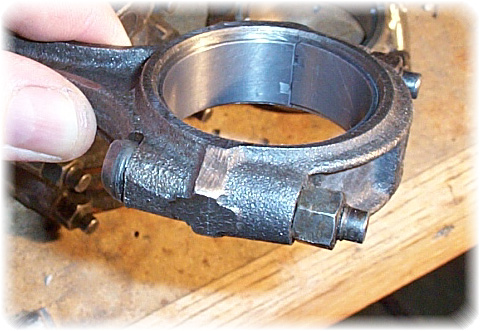

Looking at both ends of the
connecting rods, one can see the balance pads. This is the
area on the rods which was forged into the part, specifically to
be removed as needed to balance the rods one to another.
The image on the left is obviously the small end (piston end) of the connecting rod, and the right
image is the crank end. The piston end has been ground down
at the factory. Since all the rods weighed about the same (within
3 grams of one another) and only the piston end was machined, I
assume that this was the factory practice, to simply weigh the
rods and remove weight from one end only.
Following Richard Finch and Bob
Sutcliffe's advice, I balanced each end separately.


Here's the completed stack.
 |
Rather than just grind more from the top of
the pad as the factory did, I removed most of the mass from
the corners, rounding the pad quite a bit. This was
pretty straight forward.
All in all, not much material had to be
removed from the piston end of the connecting rod.
|
| Notice how the second from the top, and the
bottom rods don't have any work done to the piston end balance
pad. That's because these two were the lightest, at 113
grams. The other's were anywhere from 115g to 123g. |

|
 
On several of the crank ends, I chose to
not use just the balancing pad for weight removal. In fact if
I had, I would have not only run completely out of material to
remove, but in my opinion, I would have weakened the
cap. So I opted to remove excess material before starting to
grind on the balancing pad. I did this to every rod,
even if only a gram or two was to be removed.
Also see page 15 of Clark's "Otto"
catalog to see where they remove material to lighten rods.
The left image shows a rod which has not been
ground. The right image shows one which only a little bit of
weight was removed. The material removed is part of the excess
which Bob removes when he lightens rods, so I felt it was safe
to start here. |
 |
This rod needed just a bit more weight removed than
the rod in the previous photo... |
|
...but this one needed a bit more. This is
about as far as I would go, before getting into grinding on the
balancing pad on the.
Any and all grinding was followed up with some very
fine sanding (polishing) to reduce the stress riser effect of the
scratches left by the grinding wheel. |
 |
On the left is a stock rod bearing cap.
On the right is one which has been ground down by about 1.5 - 2 grams.
 |
This one however has a good 4-5 grams
removed. Notice that I dished out the pad, rather than just
grind it off along with the ribs which make up the "C" section
beam. |
|
And this is the finished stack. The top one
has just a little removed, the next two substantially more,
the next two none, and the bottom one, a whole bunch.
I started out with the small ends weighing anywhere
from 308g to 316g and the big end weighing 113g to 123.
Now the small ends weigh within 1g of 113g,
and the big ends weigh within 1g of 305g.
All together I took 10g off each rod. |
 |
|

